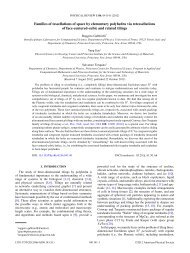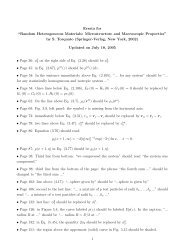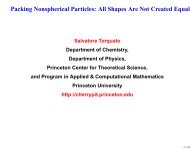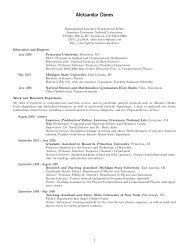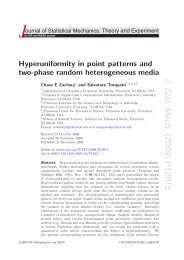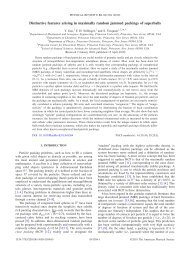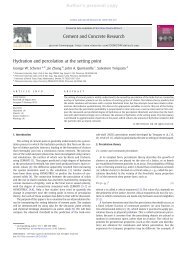Statistical properties of determinantal point processes in high ...
Statistical properties of determinantal point processes in high ...
Statistical properties of determinantal point processes in high ...
You also want an ePaper? Increase the reach of your titles
YUMPU automatically turns print PDFs into web optimized ePapers that Google loves.
SCARDICCHIO, ZACHARY, AND TORQUATO PHYSICAL REVIEW E 79, 041108 2009<br />
G(r)<br />
3<br />
2.5<br />
2<br />
1.5<br />
1<br />
0.5<br />
d=1<br />
d=2<br />
0<br />
0 0.5 1 1.5 2 2.5 3 3.5 4 4.5<br />
r<br />
accurately obta<strong>in</strong>ed, we assume this asymptotic convergence<br />
and provide results for the asymptotic slope <strong>of</strong> GV below.<br />
Table II collects our calculations for the slope <strong>of</strong> GV <strong>in</strong> each<br />
dimension for large r. The slopes are calculated by fitt<strong>in</strong>g the<br />
large-r portion <strong>of</strong> each quantity to a function <strong>of</strong> the form<br />
n<br />
Fx = a0x + a1 + ai i=2<br />
1 i−1<br />
. 77<br />
x<br />
It has been conjectured <strong>in</strong> 6 that as the dimension d<br />
f<strong>in</strong>ite <strong>of</strong> the system <strong>in</strong>creases, the asymptotic slope <strong>of</strong> GV and GP should approach the correspond<strong>in</strong>g value for a Poisson<br />
<strong>po<strong>in</strong>t</strong> process <strong>in</strong> dimension d+1. The results <strong>in</strong> Table II<br />
<strong>in</strong>dicate that this claim closely holds for d=3 and 4, mean<strong>in</strong>g<br />
that the convergence <strong>of</strong> <strong>processes</strong> is relatively quick with<br />
respect to <strong>in</strong>creas<strong>in</strong>g dimension. Based on the analysis <strong>in</strong> 6,<br />
we therefore expect this trend to cont<strong>in</strong>ue for <strong>high</strong>er dimensions.<br />
3. Voronoi statistics <strong>of</strong> the Fermi-sphere <strong>po<strong>in</strong>t</strong> process for d=2<br />
To demonstrate the utility <strong>of</strong> the HKPV algorithm <strong>in</strong> statistically<br />
characteriz<strong>in</strong>g a <strong>po<strong>in</strong>t</strong> process, we have also <strong>in</strong>cluded<br />
statistics for the Voronoi tessellation <strong>of</strong> the d=2<br />
Fermi sphere <strong>po<strong>in</strong>t</strong> process <strong>in</strong> Table III. Specifically, we provide<br />
results for the probability distribution <strong>of</strong> the number <strong>of</strong><br />
cell sides p n and the average area <strong>of</strong> an n-sided cell A n.<br />
Similar results have been reported <strong>in</strong> the literature for<br />
Voronoi tessellations <strong>of</strong> Poisson <strong>po<strong>in</strong>t</strong> <strong>processes</strong> 37 and <strong>determ<strong>in</strong>antal</strong><br />
<strong>po<strong>in</strong>t</strong> <strong>processes</strong> generated from the eigenvalues<br />
G(r)<br />
1<br />
0.9<br />
0.8<br />
0.7<br />
0.6<br />
0.5<br />
0.4<br />
0.3<br />
0.2<br />
0.1<br />
d=3<br />
d=4<br />
0<br />
0 0.5 1 1.5 2 2.5 3<br />
r<br />
FIG. 10. Color onl<strong>in</strong>e Plots <strong>of</strong> G ˜ r=G Vr−G Pr for d=1,2,3,and4.<br />
TABLE II. Large-r slopes <strong>of</strong> G V for each dimension. The d=1<br />
slope is taken from the asymptotic expansion <strong>in</strong> 57. Given errors<br />
are estimated based on the approximate error for d=1.<br />
d G V<br />
1 2 /2 exact<br />
2 2.4990.015<br />
3 1.6800.025<br />
4 1.3230.049<br />
041108-14<br />
<strong>of</strong> complex random matrices 38; we also provide the comparison<br />
<strong>in</strong> Table III. Visual representations <strong>of</strong> the data are<br />
shown <strong>in</strong> Fig. 11.<br />
The topology <strong>of</strong> the plane enforces the constra<strong>in</strong>ts that<br />
n=6 and A=1/ =1 at unit density for any <strong>po<strong>in</strong>t</strong> process,<br />
where n is the number <strong>of</strong> cell sides and A is the area <strong>of</strong><br />
a cell. We notice that the distribution pn is more sharply<br />
peaked for the Fermi-sphere <strong>po<strong>in</strong>t</strong> process than <strong>in</strong> the Poisson<br />
<strong>po<strong>in</strong>t</strong> process, which is a consequence <strong>of</strong> the effective<br />
repulsion among the particles. With regard to the average<br />
areas <strong>of</strong> cells, is appears that Fermi-sphere cells with smaller<br />
n have larger areas than Poisson cells, aga<strong>in</strong> likely due to the<br />
repulsion <strong>of</strong> the <strong>po<strong>in</strong>t</strong>s; however, Poisson cells with a greater<br />
number <strong>of</strong> sides tend to have larger areas than Fermi-sphere<br />
cells, a result which can be attributed to the more even distribution<br />
<strong>of</strong> <strong>po<strong>in</strong>t</strong>s <strong>in</strong> the Fermi-sphere process through<br />
space, which is related to the hyperuniformity <strong>of</strong> the <strong>po<strong>in</strong>t</strong><br />
process. Figure 12 shows a typical Voronoi tessellation for<br />
the Fermi-sphere <strong>po<strong>in</strong>t</strong> process compared to the equivalent<br />
tessellation for a Poisson <strong>po<strong>in</strong>t</strong> process. We immediately notice<br />
that the <strong>determ<strong>in</strong>antal</strong> <strong>po<strong>in</strong>t</strong> process tends to avoid cluster<strong>in</strong>g<br />
<strong>of</strong> particles, result<strong>in</strong>g <strong>in</strong> a narrower distribution <strong>of</strong> cell<br />
sizes with<strong>in</strong> the tessellation; such cluster<strong>in</strong>g is not precluded<br />
<strong>in</strong> the Poisson tessellation, result<strong>in</strong>g <strong>in</strong> isolated regions <strong>of</strong><br />
small or large cells.<br />
In order to rationalize these <strong>properties</strong>, we utilize the hyperuniformity<br />
superhomogeneity <strong>of</strong> the Fermi-sphere <strong>po<strong>in</strong>t</strong><br />
process. Voronoi tessellations <strong>of</strong> hyperuniform <strong>po<strong>in</strong>t</strong> <strong>processes</strong><br />
share several unique characteristics which dist<strong>in</strong>guish<br />
them from general <strong>po<strong>in</strong>t</strong> <strong>processes</strong>. For example, Gabrielli<br />
and Torquato 17 have provided the follow<strong>in</strong>g summation<br />
rule, which holds for all hyperuniform <strong>po<strong>in</strong>t</strong> <strong>processes</strong> <strong>in</strong> any<br />
dimension:<br />
NS<br />
+<br />
lim<br />
V→ wiwj= Cij =0, 78<br />
j=1<br />
j=−<br />
where V is the system volume, NS is the number <strong>of</strong> <strong>po<strong>in</strong>t</strong>s<br />
<strong>in</strong> a large subset S <strong>of</strong> V, wi=v i−1/, vi is the size <strong>of</strong> Voronoi<br />
cell i, and Cij=w iwj def<strong>in</strong>es the correlation matrix between<br />
the sizes <strong>of</strong> different Voronoi cells. We note that this rule is



